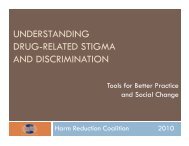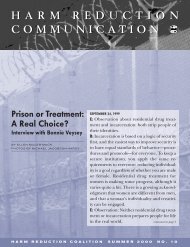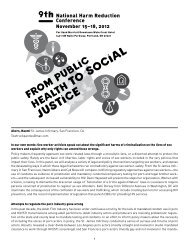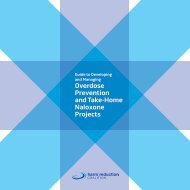PROMOTING SECONDARY EXCHANGE: - Harm Reduction Coalition
PROMOTING SECONDARY EXCHANGE: - Harm Reduction Coalition
PROMOTING SECONDARY EXCHANGE: - Harm Reduction Coalition
Create successful ePaper yourself
Turn your PDF publications into a flip-book with our unique Google optimized e-Paper software.
program showed that 78.3% of SEP<br />
participants reported sharing with a close<br />
friend. The study found that IDUs engage in<br />
selective risk taking – only sharing syringes<br />
with close friends or people with whom<br />
they had strong ties in their peer networks.<br />
Risk taking was not random; IDUs were<br />
less likely to share syringes with strangers<br />
or weaker-known associates. This was<br />
particularly true for women, who are more<br />
likely to share syringes with close friends or<br />
partners.<br />
Researchers noted that when networks<br />
are relatively closed, with low disease<br />
prevalence rates among the group, the IDU<br />
is ‘protected’ or insulated from outside<br />
exposure. However, researchers also<br />
found that there is significant turnover<br />
within close-friend networks; the role of<br />
‘close-friend’ changes over time. 15 For<br />
syringe exchange programs and secondary<br />
exchange models, these findings represent<br />
an opportunity to tailor disease prevention<br />
messages and provide targeted counseling<br />
on syringe sharing and risk behavior in the<br />
context of close friendships, partnerships,<br />
and peer networks.<br />
An innovative peer model recently<br />
established in Russia developed formal<br />
secondary exchange methods to counteract<br />
the overwhelming operational barriers<br />
(such as oppressive law enforcement tactics)<br />
to reach Russia’s largely ‘hidden’ IDU<br />
population. To offset these profound legal<br />
and law enforcement obstacles, advocates<br />
created an alternative SEP model that<br />
employed peer educators and actively<br />
recruited IDUs to promote secondary<br />
exchange. Since its inception, Project<br />
Renewal’s secondary exchange model is<br />
utilized more than the primary SEP program<br />
at both the fixed and mobile sites. 16<br />
Promoting secondary<br />
exchange: policy and public<br />
health goals<br />
Research demonstrates that the most<br />
effective disease prevention occurs when<br />
IDUs receive both sterile syringes and risk<br />
reduction messages during SEP transactions<br />
and encounters with staff. IDUs who visit<br />
SEPs consistently, exchange syringes for<br />
personal use, have access to ancillary social<br />
services and sustained engagement with<br />
harm reduction staff, have the lowest<br />
likelihood of HIV transmission, because they<br />
receive both sterile syringes and messages<br />
which influence individual behavioral<br />
change. Against the backdrop of limited<br />
resources and structural barriers to expand<br />
syringe access—as well as overall changing<br />
drug use trends—secondary exchange can<br />
enhance public health by increasing sterile<br />
syringe circulation in the IDU community. 17<br />
By using more formal peer education with<br />
SEP participants who perform secondary<br />
exchange, SEPs can capitalize on access<br />
to non-SEP-using IDUs and enhance<br />
their capacity to promote risk reduction<br />
strategies.<br />
1. Wodak, A, Cooney A. (2005) Effectiveness of sterile needle and syringe programs. International Journal of Drug Policy 16 (Supplement): S31:S44.<br />
2. Centers for Disease Control and Prevention http://www.cdc.gov/mmwr/preview/mmwrhtml/mm5427a1.htm<br />
3. Secondary exchange refers to the practice whereby a participant at a syringe exchange program receives more syringes than needed for their personal use and<br />
re-distributes sterile syringes among their peer networks and associates. Whereas satellite exchange refers to the practice of distributing large quantities of sterile<br />
syringes (through shipping or delivering) to locations that do not have syringe exchange programs (or very limited SEPs). The most notable difference in these<br />
practices is that secondary exchange often occurs among known associates and peers, and satellite exchange happens outside a personal network in a given<br />
community when syringes are distributed at a distance from the original exchanger. Both practices are quasi-legal based on state or local policies.<br />
4. Des Jarlais DC, McKnight C, Eigo K, Friedmann, P. (2000). Unites States Syringe Exchange Program Survey. North American Syringe Exchange Convention.<br />
5. Huo et al. (2005). Drug Use and HIV Risk Practices of Secondary and Primary Needle Exchange Users. AIDS Education and Prevention. Vol. 17(2).<br />
6. Snead, J., Moher, D., Lorvick, J., Garcia, B., Thawley, R., Kegeles, S., Edlin, B., (2003). Secondary Syringe Exchange Among Injection Drug Users. Journal of<br />
Urban Health Vol. 80 (2).<br />
7. Murphy et al. (2004). The Health Benefits of Secondary Syringe Exchange. The Journal of Drug Issues. Vol. 34.<br />
8. Booth, RE. (1995). Gender Differences in High-risk Sex Behaviors Among Heterosexual Drug Injectors and Crack Smokers. American Journal of Alcohol Abuse<br />
Vol. 21.<br />
9. Snead, J., Moher, D., Lorvick, J., Garcia, B., Thawley, R., Kegeles, S., Edlin, B., (2003). Secondary Syringe Exchange Among Injection Drug Users. Journal of<br />
Urban Health Vol. 80 (2).<br />
10. Lenton et al. (2006). Threat or Opportunity? Secondary Exchange in a Setting With Widespread Availability of Needles Substance Use & Misuse, 41:845-846.<br />
11. Murphy, S., Kelley, M., Lune, H. (2004). The Health Benefits of Secondary Syringe Exchange. Journal of Drug Issues. Vol. 34 (2)<br />
12. Riehman, K., Alex, K., Anderson, R., Flynn, N., Bluthenthal, R., (2004). Sexual Relationships, Secondary Exchange, and Gender Differences in HIV Risk<br />
Among Drug Injectors. Journal of Urban Health, Vol. 81 (2).<br />
13. Valente et al. (2001) Needle Exchange Participation, Effectiveness, and Policy: Syringe Relay, Gender, and the Paradox of Public Health. Journal of Urban<br />
Health. Vol. 78 (2).<br />
14. Snead et al. (2003). Secondary Syringe Exchange Among Injection Drug Users Journal of Urban Health: Bulletin of the New York Academy of Medicine.<br />
15. Valente, TW, Vlahov, D (2001). Selective Risk Taking Among Needle Exchange Participants: Implications for Supplemental Interventions. American Journal of<br />
Public Health. Vol. 91 No. 3.<br />
16. Irwin, K., et al (2006). Secondary Syringe Exchange as a Model for HIV Prevention in the Russian Federation. Substance Use & Misuse Vol. 41<br />
17. Valente et al. (2001) Needle Exchange Participation, Effectiveness, and Policy: Syringe Relay, Gender, and the Paradox of Public Health. Journal of Urban<br />
health: Bulletin of the New York Academy of Medicine.<br />
<strong>Harm</strong> <strong>Reduction</strong> <strong>Coalition</strong><br />
22 West 27th Street, 5th Floor<br />
New York, NY 10001<br />
Tel: (212) 213-6376 Fax: (212) 213-6582<br />
www.harmreduction.org<br />
e-mail: hrc@harmreduction.org











